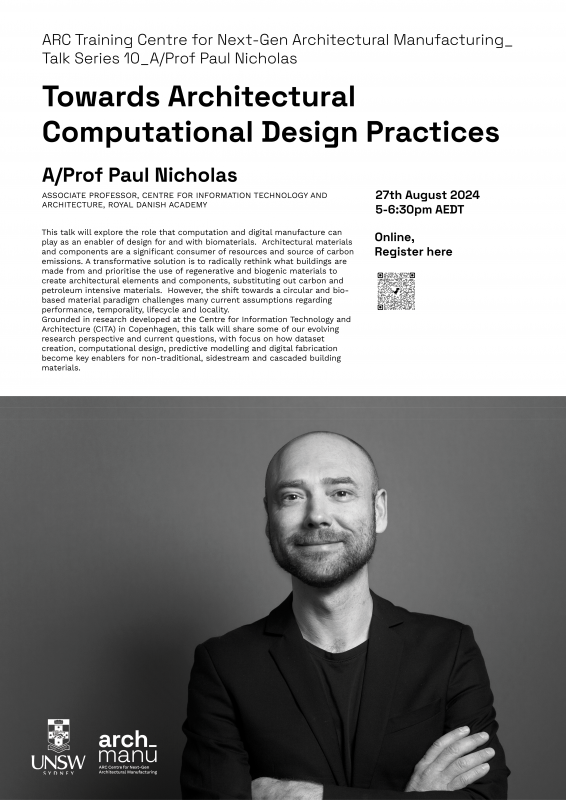
- This event has passed.
Towards Architectural Computational Design Practices for Bio materials / Paul Nicholas
August 27, 2024 | 5:00 pm - 6:30 pm
Title
Towards Architectural Computational Design Practices for Bio materials.
Speaker
Associate Professor Paul Nicholas
Associate Professor Paul Nicholas investigates how computational design and fabrication technologies can enable more sustainable and circular architecture. Current projects bridge between research and industry, and explore additive manufacture with biomaterials made from agricultural waste streams, customized robotic fabrication of sheet metals for extremely strong but lightweight structures, and ml-based predictive modelling methods for behaviour prediction and fabrication. Paul’s work and research has been exhibited worldwide including at the Venice biennale Australian and Danish pavilions. Paul is associate professor at CITA at the Royal Danish Academy, has worked in practice with Arup and AECOM, and founded and directs the international 2 year masters program Computation in Architecture. The program fosters a dynamic, creative, intellectually rigorous and design-led environment that explores critical issues of Resource, Living Materials and Advanced Fabrication to stimulate critical inquiry and develop situated knowledge in the concepts, technological trajectories and practices that will drive future practice.
Date
27th August 2024, 5-6:30pm AEST, Online
Register at this link
Abstract
Join us for Arch_Manu Talk Series 10, featuring: Associate Professor Paul Nicholas, Centre for Information Technology and Architecture, Royal Danish Academy.
Titled ‘Towards Architectural Computational Design Practices for Bio materials.’ This talk will explore the role that computation and digital manufacture can play as an enabler of design for and with biomaterials. Architectural materials and components are a significant consumer of resources and source of carbon emissions. A transformative solution is to radically rethink what buildings are made from and prioritise the use of regenerative and biogenic materials to create architectural elements and components, substituting out carbon and petroleum intensive materials. However, the shift towards a circular and bio-based material paradigm challenges many current assumptions regarding performance, temporality, lifecycle and locality.
Grounded in research developed at the Centre for Information Technology and Architecture (CITA) in Copenhagen, this talk will share some of our evolving research perspective and current questions, with focus on how dataset creation, computational design, predictive modelling and digital fabrication become key enablers for non-traditional, sidestream and cascaded building materials.
